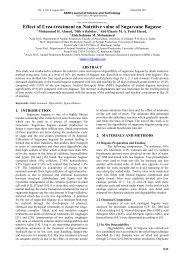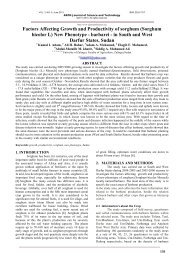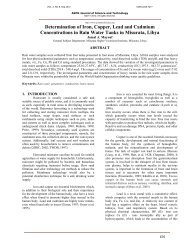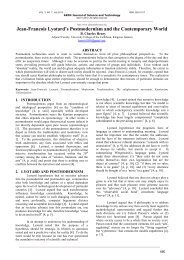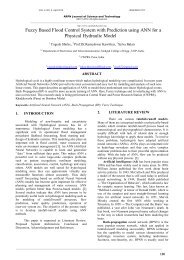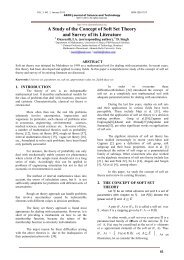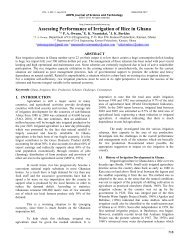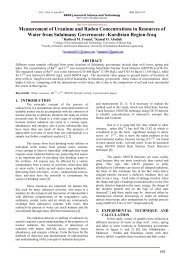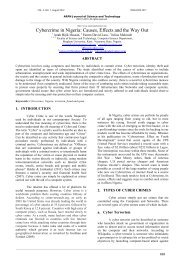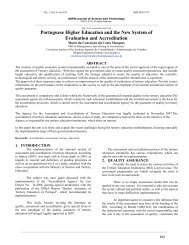Weights of Road Accident Causes using Analytic Hierarchy Process
Weights of Road Accident Causes using Analytic Hierarchy Process
Weights of Road Accident Causes using Analytic Hierarchy Process
You also want an ePaper? Increase the reach of your titles
YUMPU automatically turns print PDFs into web optimized ePapers that Google loves.
VOL. 2, NO. 2, March 2012 ISSN 2225-7217<br />
ARPN Journal <strong>of</strong> Science and Technology<br />
©2011-2012. All rights reserved.<br />
conditions and other (20.8%), attention in the road (23%)<br />
and emergencies such as tyres and brakes failure (1.4%).<br />
The tyres and brakes defect usually because <strong>of</strong> lack <strong>of</strong><br />
maintenance and services. As mentioned above,<br />
drowsiness also leads to road accident with the percentage<br />
<strong>of</strong> 3.9% [2]. Generally the drowsy drivers could contribute<br />
themselves to the statistic <strong>of</strong> the road accident injured and<br />
that is why the drowsy can be one <strong>of</strong> the hazard factors<br />
contributing to the road accident.<br />
In order to overcome the road accidents problem, there are<br />
lots <strong>of</strong> researches on investigating the causal <strong>of</strong> road<br />
accident, but generally lack <strong>of</strong> study about the decision on<br />
the most important causes contributing to the road<br />
accidents. Fuzzy approach can be one <strong>of</strong> method to<br />
recognize the causes associated with road accident since<br />
road accident problems are one <strong>of</strong> the uncertainty cases to<br />
happen. Recently, Lazim Abdullah and Nurnadiah Zamri<br />
[16] used correlation analysis and Fuzzy TOPSIS to rank<br />
the factors <strong>of</strong> road accidents. Correlation analysis uses<br />
statistical data to measures the variables and Fuzzy<br />
TOPSIS uses the linguistic data collected from the expert<br />
and as part <strong>of</strong> multi-criteria decision making (MCDM).<br />
Hence, the decision making <strong>using</strong> Fuzzy approach can be<br />
use to decide the main factors <strong>of</strong> the road accidents<br />
problem. One <strong>of</strong> the most well-known methods in<br />
determining the weight for priority factors <strong>of</strong> the problem<br />
is <strong>Analytic</strong> <strong>Hierarchy</strong> <strong>Process</strong> (AHP). The AHP is<br />
practically used in many fields such as health issues,<br />
management and business, banking, sciences and<br />
engineering courses. For example, Lazim and Fateen [17]<br />
discuss the weight determination <strong>of</strong> factors related to<br />
obesity by <strong>using</strong> AHP procedures. By AHP procedures,<br />
the weight <strong>of</strong> each the factors associated with obesity is<br />
defined by comparison <strong>of</strong> pair-wise measurement for each<br />
<strong>of</strong> the factors. Recently, Liberatore [18] applied the<br />
application <strong>of</strong> AHP in medical and health care decision<br />
making. In business and economics, the AHP method can<br />
be used to define the optimum ranking <strong>of</strong> stocks for the<br />
portfolio [19]. Esra et al., [20] has been use AHP<br />
procedures to improve employee performance in<br />
organization. In addition, Hambali et al., [21] also uses<br />
AHP to select the best design concept and emphasizes the<br />
importance <strong>of</strong> making accurate decision in manufacturing<br />
and designing industrial. Newly, Sambasivan et al., [22]<br />
used the AHP to find the relative weights factors and<br />
benefits in the electrical and electronic sectors in<br />
Malaysia. Since AHP had been used widely in the many<br />
areas, thus the main purposes <strong>of</strong> this paper is to determine<br />
the weight and rank <strong>of</strong> the factors related to road accident<br />
problems. The finding from this research would help the<br />
public to understand the causal <strong>of</strong> the road accident.<br />
2. ANALYTIC HIERARCHY PROCESS<br />
The analytic hierarchy process (AHP) is a mathematical<br />
device in multi-criteria decision making which designing<br />
the decision factors in a hierarchic problem structure [23].<br />
The main target <strong>of</strong> the AHP is to decide and help decision<br />
makers in making resolution for the complex problem by<br />
structuring the criterion hierarchy <strong>of</strong> multi-criteria<br />
decision making (MCDM). The AHP is known as the most<br />
powerful tools for decision making. As the first part <strong>of</strong><br />
http://www.ejournal<strong>of</strong>science.org<br />
AHP procedures, the determination <strong>of</strong> focus or aim <strong>of</strong> the<br />
problem must identify. It is consider as the first level for<br />
the AHP hierarchy, next would be multiple criterion that<br />
define alternatives and the last level is the contributing<br />
alternatives (causes/factors) for the focus. The standard<br />
scale with absolute numbers would use as a measurement<br />
in order to manage the weight <strong>of</strong> each alternatives. The<br />
weight can be used as comparing and ranking the<br />
alternatives <strong>of</strong> the problem and lead the decision maker in<br />
making choice. The AHP method has the following<br />
general steps:<br />
a) Construct a hierarchy structure for an MADM<br />
problem.<br />
Figure-1. <strong>Hierarchy</strong> <strong>of</strong> Alternatives Selection.<br />
b) Scaling the relative <strong>of</strong> data and constructing the pairwise<br />
comparison matrixes. For this step, construct the<br />
comparison matrixes <strong>of</strong> each attributes (criteria).<br />
Thus, the matrixes would be:<br />
C 1 C 2 � n C A ij<br />
C 1 1 1 / w2<br />
w � w 1 / wn<br />
1 w<br />
C 2 w 2 / w1<br />
1 � w 2 / wn<br />
2 w<br />
� � � � � = �<br />
C n wn / w1<br />
/ w2<br />
wn � 1 w n<br />
The scale should be measurement from 1 to 9 in a<br />
fundamental scale <strong>of</strong> measurement provided by Saaty<br />
(1980). The measurement scale is shown in Table-2.1.<br />
Table-2.1. Pair-wise Comparison Scale for<br />
AHP Preference.<br />
Preference on pair wise<br />
Preference<br />
comparison<br />
number<br />
Equally important 1<br />
Moderately more important 3<br />
Strongly more important 5<br />
Very strong more important 7<br />
Extremely more important 9<br />
Intermediate value 2, 4, 6, 8<br />
c) Calculating <strong>of</strong> matrix eigenvector, Aij and consistency<br />
index test (CI) <strong>of</strong> the criterion. For matrix eigenvector,<br />
A multiply the n elements in each row, take the nth<br />
ij<br />
40



